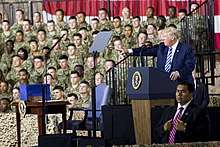John S. McCain National Defense Authorization Act for Fiscal Year 2019
The John S. McCain National Defense Authorization Act for Fiscal Year 2019 (NDAA 2019) is a United States federal law which specifies the budget, expenditures and policies of the U.S. Department of Defense (DOD) for fiscal year 2019. It was signed by President Donald Trump during a ceremony in Fort Drum, New York on August 13, 2018.[1]
.svg.png) | |
| Long title | An Act to authorize appropriations for fiscal year 2019 for military activities of the Department of Defense, for military construction, and for defense activities of the Department of Energy, to prescribe military personnel strengths for such fiscal year, and for other purposes. |
|---|---|
| Enacted by | the 115th United States Congress |
| Citations | |
| Public law | Pub.L. 115–232 |
| Statutes at Large | 132 Stat. 1636 through 132 Stat. 2423 |
| Legislative history | |
| |

Background
A Senate version of the bill contained provisions blocking a proposed settlement to lift an export denial order affecting Chinese telecommunications equipment company ZTE. The provision was not included in the final version, but it does maintain a provision banning the federal government from purchasing equipment from certain Chinese vendors due to security concerns, including Huawei and ZTE, as well as any surveillance equipment for the purposes of national security from Dahua Technology, Hytera, and Hikvision.[2][3][4]
Legislative history
House vote
H.R.5515, the version of the NDAA 2019 which was reported by the House Armed Services Committee, was passed by the House of Representatives on July 26, 2018 in a 359–54 vote.[5]
Senate vote
The Senate passed it on August 1, 2018 with a vote of 87–10.[5]
Presidential signature
President Donald Trump signed the NDAA 2019 into law on August 13, 2018.
References
- "President Signs Fiscal 2019 Defense Authorization Act at Fort Drum Cer". U.S. DEPARTMENT OF DEFENSE. Retrieved August 14, 2018.
- "Senate rejects Trump's plan to lift ZTE export ban". Ars Technica. Retrieved October 1, 2018.
- "China Contributing $500 Million to Trump-Linked Project in Indonesia". National Review. May 14, 2018. Retrieved October 1, 2018.
- "New law bans US gov't from buying tech from Chinese giants ZTE and Huawei". Ars Technica. Retrieved October 1, 2018.
- "Details for H.R. 5515: John S. McCain National Defense Authorization Act for Fiscal Year 2019 - GovTrack.us". GovTrack.us. Retrieved August 14, 2018.